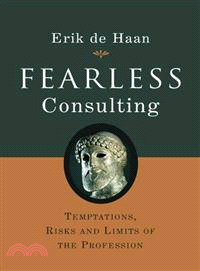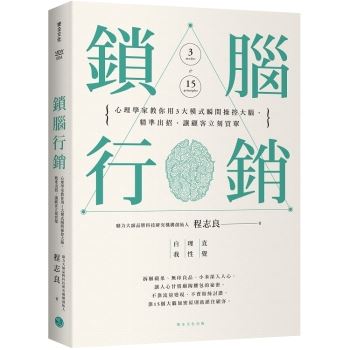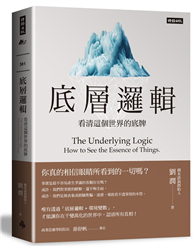| FindBook |
有 1 項符合
FEARLESS CONSULTING的圖書 |
 |
FEARLESS CONSULTING 作者:Erik De Haan 出版社:JOHN WILEY & SONS,LTD 出版日期:2006-03-10 規格: / 精裝 / 228頁 |
| 圖書館借閱 |
| 國家圖書館 | 全國圖書書目資訊網 | 國立公共資訊圖書館 | 電子書服務平台 | MetaCat 跨館整合查詢 |
| 臺北市立圖書館 | 新北市立圖書館 | 基隆市公共圖書館 | 桃園市立圖書館 | 新竹縣公共圖書館 |
| 苗栗縣立圖書館 | 臺中市立圖書館 | 彰化縣公共圖書館 | 南投縣文化局 | 雲林縣公共圖書館 |
| 嘉義縣圖書館 | 臺南市立圖書館 | 高雄市立圖書館 | 屏東縣公共圖書館 | 宜蘭縣公共圖書館 |
| 花蓮縣文化局 | 臺東縣文化處 |
|
|
- 圖書簡介
The history of consulting dates back to the original ‘intervention’ of the serpent in the Garden of Eden, and today's consultants have just as dubious a reputation. They are tempted by flattery and over-assessment of their abilities, and run the risks of uncertainty, responsibility without authority and loss of control. In order to steer a middle course, they must understand their own intention as consultants. Fearless Consulting clearly demonstrates that, in spite of the many risks and temptations, consultants can approach their profession and clients fearlessly, and offers a range of philosophical inspirations for readers as well as specific intervention models and practical methodologies.
- 作者簡介
Erik de Haan works is the director of Ashridge ’s Centre for Coaching and a senior organisation development consultant for Ashridge Consulting near London. Before joining Ashridge Consulting in 2002, he studied Theoretical Physics in Amsterdam,gained his PhD in Utrecht with his research into learning and decision-making processes in perception (1994), and worked for several consultancies in The Netherlands. Among his recent clients are the Aalsmeer Flower Auction, the BBC, BP, Credit Suisse First Boston, CSM, Fortis, Nokia, Stork, the Universities of Leeds and Leiden, and Vodafone. His previous publications books in English include The Consulting Process as Drama - King Lear for Consultants and Managers , Learning with Colleagues and Coaching with Colleagues. Erik is also member of the editorial board of Philosophy of Management –formerly Reason in Practice.
Ashridge is one of the world’s leading providers of executive education. Established in 1959, it has acquired an outstanding international reputation in helping to make a difference to both individuals and organisations through its combination of executive development, research and consultancy expertise. Its activities include open & tailored executive education programmes, MBA, MSc & Diploma qualifications, organisation consulting, applied research and online learning. Clients include leading organisations in the private and public sectors in the UK and across the globe. - 名人/編輯推薦
"...invigorating read..." (Training and Coaching Today, May 2006)
"...enliven[s] what is a rigorous academic treatment of the client advisory process..." (The Professional Manager, June 2006) - 目次
Foreword.
Preface.
Prologue: Characteristics of Consulting.
1 Characteristics of the Entry.
2 The Entry and Fearless Speech.
Communicating advice.
Four forms of argumentation.
Forms of argumentation for consultants.
The fearless consultant.
Fearless speech under pressure.
Conclusion.
3 Characteristics of Joint Problem Formulation.
4 Problem Formulation and Irony.
Ambiguous communication.
What is irony?.
Two divine examples of irony.
The ironic consultant.
Irony as an instrument for change.
Irony and the concept of fate.
Conclusion.
5 Characteristics of Intervening.
6 Intervening and Power.
Intervening means stepping in.
The focus of interventions.
The art of intervening.
The powerless consultant.
Conclusion.
7 Characteristics of Consolidating.
8 Consolidating and responsibility.
The responsibility of the consultant.
Why does anything come about?.
Authority and responsibility.
The non-responsible consultant.
Conclusion.
9 Characteristics of Departure and letting go.
10 letting go and Tragic Consulting.
The consultant as committed outsider.
The chorus in Greek tragedy
The tragic consultant.
What pleasure does a tragedy give?.
Conclusion.
Epilogue: Twenty Minutes in the life of a Consultant.
The invitation.
Observations prior to the conversation.
The conversation as it took place.
The conversation as it did not take place.
Observations following the conversation.
The follow-up conversation.
Appendix A.
Appendix B.
References.
Index.
|











